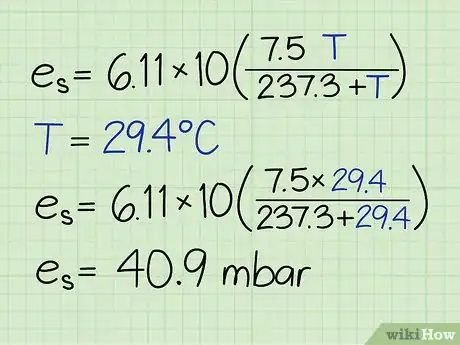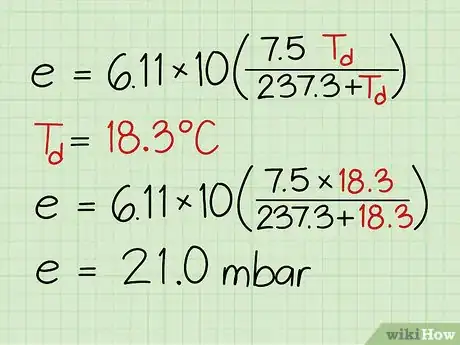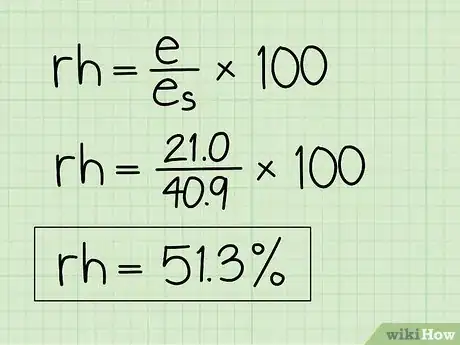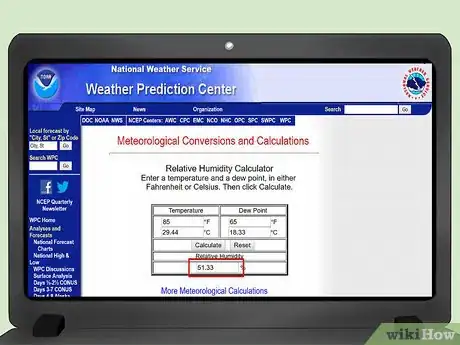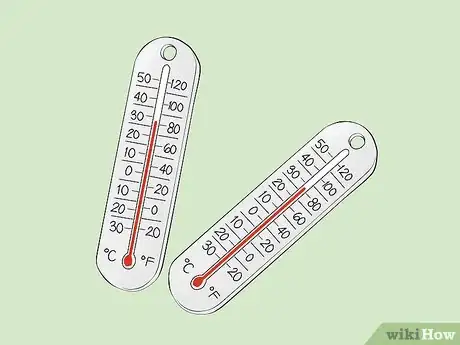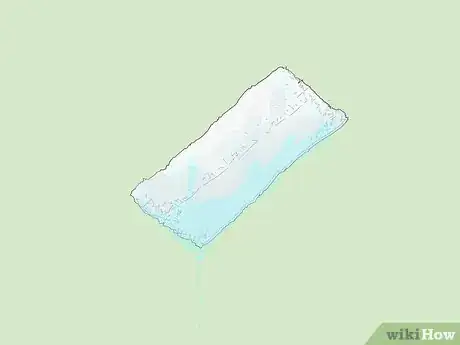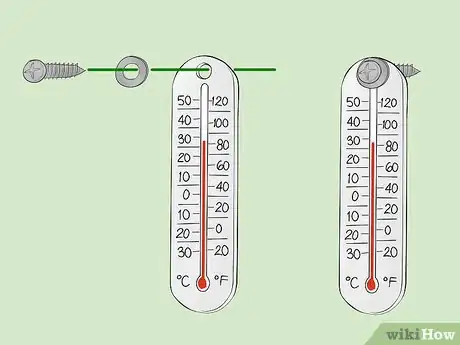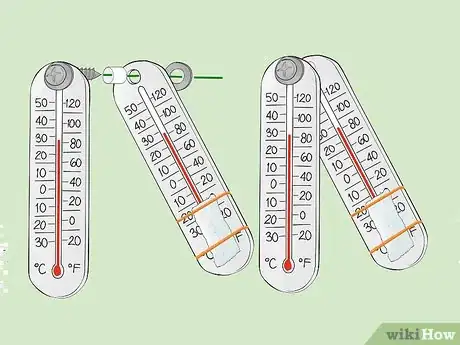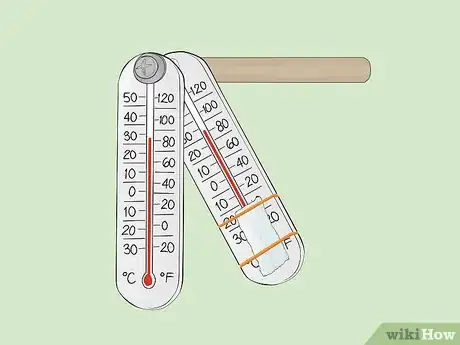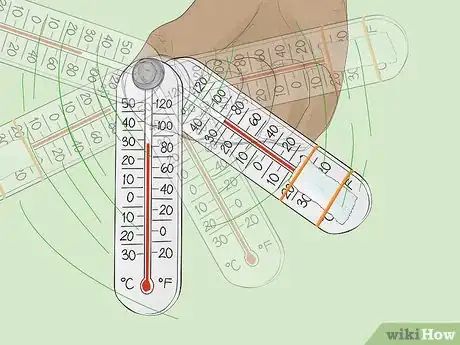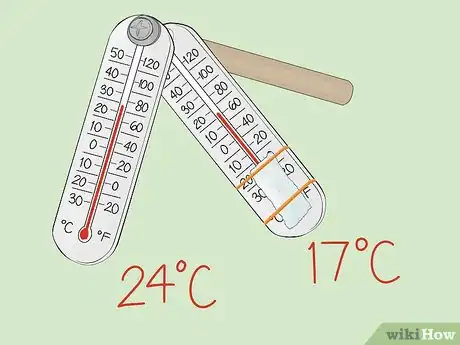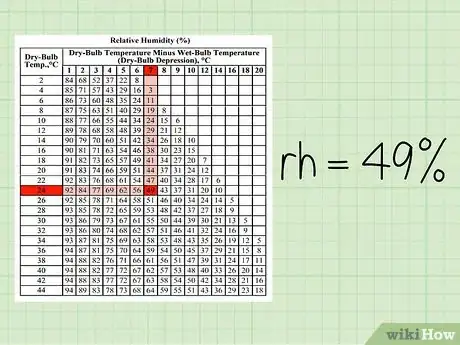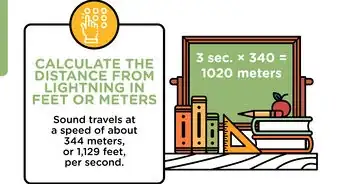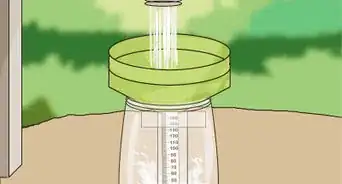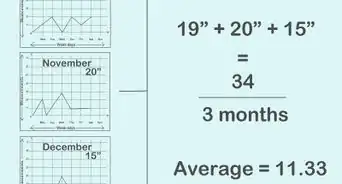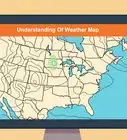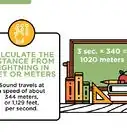wikiHow is a “wiki,” similar to Wikipedia, which means that many of our articles are co-written by multiple authors. To create this article, 25 people, some anonymous, worked to edit and improve it over time.
There are 7 references cited in this article, which can be found at the bottom of the page.
This article has been viewed 365,600 times.
Learn more...
Relative humidity, the amount of moisture in the air relative to the amount of moisture the air can hold, is an important measurement for understanding the weather. Humidity can be taken with a hygrometer or another specialized device, but it can also be calculated if you know the air temperature, the dew point, and a few simple and standard equations.[1] If you're looking for a more hands-on method, you can build a sling psychrometer, an instrument that can measure relative humidity, with some cheap supplies and simple tools.
Steps
Calculating Relative Humidity with Dew Point and Temperature
-
1Convert the air temperature and dew-point temperature to Celsius. To convert Fahrenheit to Celsius, subtract 32 from the Fahrenheit temperature. Then divide this number by the fraction 5/9. The formula should look like this:[2]
- = Celsius temperature, = Fahrenheit temperature, = Air temperature ,and = Dew point temperature
- For example, if the temperature is 100°F, you would first subtract 32 from 100, which would give you 68. Then, you would multiply 68 by 5/9, which would give you the temperature of 37.778°C.
- If you live outside the United States and use the Celsius scale, you can, of course, skip this step.
- You can also use online temperature converters to simplify this step.
-
2Calculate the saturated vapor pressure with a formula. After converting the air temperature to Celsius, you need to find out the saturated vapor pressure, or the maximum amount of water vapor the air at that temperature can hold. You can use this formula to calculate the saturated vapor pressure:[3]
- = standard vapor pressure and = air temperature
Advertisement -
3Find the actual vapor pressure with the same formula. You can use the same formula to find the actual vapor pressure. All you have to do is substitute the dew point for the air temperature in the formula.[4]
- = actual vapor pressure and = dew point
- You can find the dew point by checking the weather page of your local newspaper or a website that publishes weather information for your local area, such as weather.gov.[5]
-
4Calculate the relative humidity. Now that you have the saturated vapor pressure and the actual vapor pressure, you can find the relative humidity. Just divide the actual vapor pressure by the saturated vapor pressure and multiply that number by 100. You can use this equation:[6]
- = relative humidity, = actual vapor pressure, and = standard vapor pressure.
-
5Use an online relative humidity calculator for speed and convenience. If math is not your forte, there are several online calculators you can use to calculate relative humidity. Just punch in the temperature and dew point, and you can find out what the relative humidity is in a fraction of a second.[7]
- The National Weather Service’s relative humidity calculator is one you can use: https://www.wpc.ncep.noaa.gov/html/dewrh.shtml
Finding Relative Humidity with a Sling Psychrometer
-
1Buy two identical plastic student thermometers. A plastic student thermometer is a cheap tube thermometer affixed on a white plastic backing. They are typically around 2 inches (5.1 cm) wide and 6 inches (15 cm) long, and have a hole through the top of the plastic backing and a bulb at the bottom of the tube. The thermometers should also be mercury-free.[8]
- You should be able to find plastic student thermometers at most office supply stores and some major retailers.
-
2Soak a small piece of white, porous cloth in water. Start making your psychrometer by soaking a cloth in water. The cloth should be about 2 inches (5.1 cm) long.[9]
- A section of hollow shoelace, for example, would work. Simply slit the shoelace down the middle to create a single layer of cloth.
-
3Wrap the cloth around the bulb of one of the thermometers. Use a rubber band or piece of string to secure the wet cloth against the bulb of the thermometer, which is the bottommost part of the thermometer. This thermometer will be your wet-bulb thermometer.[10]
- The thermometer without a wet cloth will be your dry-bulb thermometer.
-
4Put a washer and thermometer onto a 2 in (5.1 cm) metal screw. First slide the washer onto the screw. Then put the screw through the hole of one of your two thermometers. It doesn’t matter which thermometer you first put on the screw.[11]
-
5Put a plastic spacer, thermometer, and washer onto the same screw. After the washer and thermometer are on the screw, cut a 0.5 in (1.3 cm) section of a plastic straw, and slide it on. Then add the other thermometer and another washer.[12]
- You can use another type of plastic spacer if it’s about the same size.
-
6Tighten the screw into a 6 in (15 cm) long wooden dowel. Use a screwdriver to fix the screw into the dowel. Tighten the screw just enough so that it is secure. Be sure to leave plenty of room for the two thermometers to swing.[13]
-
7Swing the thermometers for 10 to 20 seconds. Hold the dowel out from your body and spin it so that the two thermometers whirl around the screw. As you swing the thermometers, water will evaporate from the wet cloth you attached to your wet-bulb thermometer. This evaporation will cool the bulb and lower the temperature recorded on the wet-bulb thermometer.[14]
- Be sure to wear safety glasses during this step.
-
8Record temperatures from the two thermometers. After whirling the thermometers for 10 to 20 seconds, stop and look at the temperatures displayed on the thermometers. Write down the temperatures in a notebook.[15]
- Read the temperature from the wet-bulb thermometer first for an accurate reading.
- Mark down which temperature reading is from the wet-bulb thermometer and which is from the dry-bulb thermometer.
-
9Subtract the wet-bulb temperature from the dry-bulb temperature. Because of evaporation, the temperature on the wet-bulb thermometer will be lower than the temperature on the dry-bulb thermometer. The drier the air, the lower the wet-bulb temperature will be relative to the dry-bulb temperature.[16]
- Whirling the thermometer causes moisture from the wet cloth to evaporate. The process of evaporation removes heat from the environment, leading to a lower temperature reading on the wet-bulb thermometer.
- More evaporation takes place when the air is dry because dry air has a higher capacity than moist air to absorb additional moisture.
-
10Consult a relative humidity chart or table. From these readings, you can figure out the relative humidity. Just find where the dry-bulb temperature and the difference between the wet- and dry-bulb readings intersect on the chart. You can find a decent relative humidity chart at the following link: https://www.iowadot.gov/erl/archiveoct2011/IM/content/382.pdf
- While this method will not give you a 100% accurate reading of relative humidity, it will give you an approximate measurement of how much water vapor there is in the air.
Community Q&A
-
QuestionIf it is raining heavy (like in the outer parts of a hurricane), shouldn't the humidity level be 100%?
 DonaganTop AnswererNot necessarily. The presence of lots of rain doesn't tell us for sure what the humidity is. Humidity refers to the air's water content, which is sometimes invisible.
DonaganTop AnswererNot necessarily. The presence of lots of rain doesn't tell us for sure what the humidity is. Humidity refers to the air's water content, which is sometimes invisible. -
QuestionWhat is the ideal humidity on a gauge?
 Community AnswerYou will have to use a thermo and calculator and follow the steps. First measure the temperature, then wind pressure, and then divide them.
Community AnswerYou will have to use a thermo and calculator and follow the steps. First measure the temperature, then wind pressure, and then divide them. -
QuestionIs there any particular name for that temperature difference between wet and dry bulbs?
 Community AnswerThe difference between dry bulb and wet bulb temperature is called wet bulb depression. Likewise the difference between temperature and dewpoint is referred to as the dewpoint depression.
Community AnswerThe difference between dry bulb and wet bulb temperature is called wet bulb depression. Likewise the difference between temperature and dewpoint is referred to as the dewpoint depression.
References
- ↑ https://www.weather.gov/lmk/humidity
- ↑ https://www.weather.gov/media/epz/wxcalc/tempConvert.pdf
- ↑ https://www.weather.gov/media/epz/wxcalc/vaporPressure.pdf
- ↑ https://www.weather.gov/media/epz/wxcalc/vaporPressure.pdf
- ↑ https://www.weather.gov
- ↑ https://www.weather.gov/media/epz/wxcalc/vaporPressure.pdf
- ↑ https://www.wpc.ncep.noaa.gov/html/dewrh.shtml
- ↑ https://www.nasa.gov/centers/langley/pdf/245887main_MeteorologyTeacherRes-Ch11.r3.pdf
- ↑ http://www.atmo.arizona.edu/students/courselinks/spring08/atmo336s1/courses/fall19/atmo170a1s1/lecture_notes/humidity/measuring_humidity.html
- ↑ http://www.atmo.arizona.edu/students/courselinks/spring08/atmo336s1/courses/fall19/atmo170a1s1/lecture_notes/humidity/measuring_humidity.html
- ↑ https://www.nasa.gov/centers/langley/pdf/245887main_MeteorologyTeacherRes-Ch11.r3.pdf
- ↑ https://www.nasa.gov/centers/langley/pdf/245887main_MeteorologyTeacherRes-Ch11.r3.pdf
- ↑ https://www.nasa.gov/centers/langley/pdf/245887main_MeteorologyTeacherRes-Ch11.r3.pdf
- ↑ https://www.nasa.gov/centers/langley/pdf/245887main_MeteorologyTeacherRes-Ch11.r3.pdf
- ↑ https://www.nasa.gov/centers/langley/pdf/245887main_MeteorologyTeacherRes-Ch11.r3.pdf
- ↑ https://www.nasa.gov/centers/langley/pdf/245887main_MeteorologyTeacherRes-Ch11.r3.pdf
About This Article
You can calculate the relative humidity, or the amount of moisture in the air, if you know the air temperature and dew point. While you can use complicated mathematical equations, if math is not your forte then simply look up a relative humidity calculator online. Just punch in the temperature and dew point, and you can find out the relative humidity in a fraction of a second. To learn how to find relative humidity with a sling psychrometer, keep reading!






